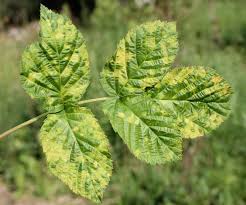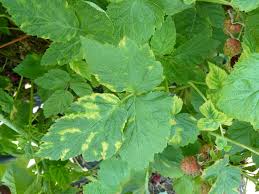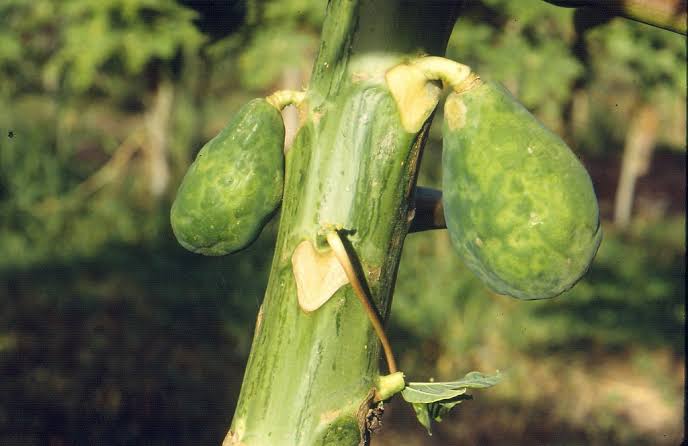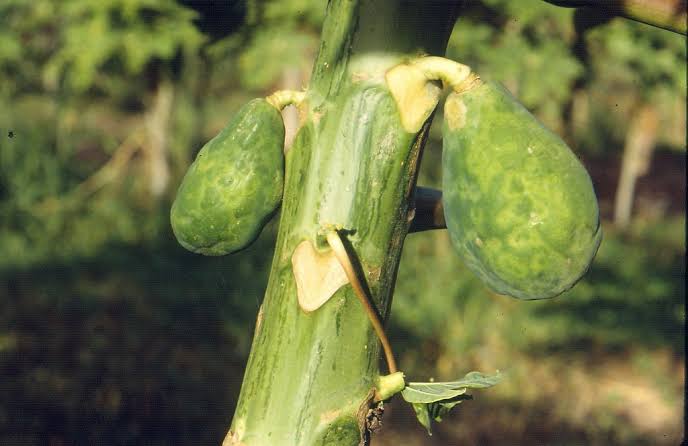Ringspot viruses, scientifically known as Tobravirus, are a group of plant viruses that affect a variety of crops, including fruits and vegetables. One of the well-known examples is the Raspberry Ringspot Virus, which poses a threat to raspberry plants.
These viruses get their name from the characteristic ring-shaped lesions or spots that appear on the leaves and other parts of infected plants. The viruses are transmitted through various means, such as contaminated tools, sap, or by insects like aphids. Once a plant is infected, it can lead to a range of symptoms affecting its growth and overall health.
Raspberry Ringspot Virus, specifically, targets raspberry plants, causing distinct ringspots on the leaves. These ringspots are essentially areas of the leaf where the virus has disrupted normal cell growth, resulting in a visible circular pattern. As the infection progresses, the leaves may become distorted, and the overall vigor of the plant diminishes.
The impact of Ringspot viruses extends beyond mere visual symptoms. These viruses can affect the yield and quality of crops, leading to economic losses for farmers. Additionally, the ability of these viruses to spread easily poses a challenge for agricultural management.
Controlling Ringspot viruses involves implementing preventive measures, such as using disease-resistant plant varieties, employing proper sanitation practices, and managing insect vectors. Farmers may also resort to cultural practices like crop rotation to reduce the risk of virus buildup in the soil.
Research continues to explore ways to develop more effective control strategies and understand the molecular mechanisms of these viruses. Scientists are working towards developing resistant plant varieties and enhancing our understanding of the complex interactions between the virus, the host plant, and the environment.
Additionally, Ringspot viruses, including the Raspberry Ringspot Virus, are a concern in agriculture due to their ability to impact various crops. Understanding their biology, transmission methods, and implementing effective control measures are crucial for safeguarding plant health and ensuring sustainable agricultural practices.
Read Also: Stardew Valley Tilapia: Where to Catch them, their Uses, etc.
Plants Affected by Ringspot Viruses (Tobravirus)

Ringspot viruses can affect a wide range of plants, causing damage to crops and posing challenges for farmers. While the specific host plants can vary depending on the type of Ringspot virus, here are some examples of plants commonly affected:
1. Raspberry Plants: Raspberry Ringspot Virus is particularly known for infecting raspberry plants, leading to characteristic ringspots on the leaves.
2. Tomato Plants: Some Ringspot viruses can also impact tomato plants, affecting their growth and fruit development.
3. Potato Plants: Certain Ringspot viruses may infect potato plants, potentially reducing yield and quality.
4. Tobacco Plants: Tobacco is susceptible to Ringspot viruses, and infections can affect the overall health of the plants.
5. Bean Plants: Ringspot viruses can target bean plants, causing symptoms like leaf distortion and reduced crop productivity.
6. Lettuce Plants: Lettuce is not immune to Ringspot viruses, and infections can lead to visible damage on the leaves.
7. Cucumber Plants: Some Ringspot viruses may affect cucumber plants, impacting both foliage and fruit development.
8. Ornamental Plants: Various ornamental plants, including flowers and shrubs, can be susceptible to Ringspot viruses, affecting their aesthetics.
It’s important to note that the range of host plants for Ringspot viruses is extensive, and the impact on different crops can vary. The ability of these viruses to infect diverse plant species underscores the need for comprehensive strategies in agriculture to manage and mitigate their effects on various crops.
Damages Caused by Ringspot Viruses

Ringspot viruses can inflict significant damage on infected plants, affecting both their appearance and productivity. The damages caused by Ringspot viruses include:
1. Lesions and Ringspots: The hallmark damage is the appearance of circular lesions or ringspots on leaves, stems, and other plant parts. These spots are areas where the virus has disrupted normal cell growth, leading to visible patterns.
2. Leaf Distortion: Infected plants often exhibit distorted leaves, which can affect their ability to photosynthesize and, consequently, impact overall plant health.
3. Reduced Growth and Vigor: Ringspot viruses compromise the growth and vigor of infected plants. This reduction in overall plant health can lead to stunted growth and diminished crop yields.
4. Fruit Deformities: In crops where the fruit is the economic product, Ringspot virus infections can result in deformities and reduced quality of the harvested produce.
5. Yield Loss: The impact of Ringspot viruses on crop yields can be substantial. Reduced plant health, distorted leaves, and compromised fruit quality contribute to decreased overall productivity.
6. Transmission to Offspring: Ringspot viruses can be transmitted to the next generation of plants through infected seeds. This perpetuates the cycle of infection and poses challenges for maintaining healthy crops.
7. Economic Losses: The cumulative effect of Ringspot virus damages results in economic losses for farmers. Decreased yields, lower quality produce, and the cost of implementing control measures contribute to financial setbacks.
8. Spread to Surrounding Plants: Ringspot viruses can spread easily, either through contaminated tools, sap, or insect vectors. This facilitates the rapid transmission of the virus to nearby healthy plants, increasing the overall impact on crops.
9. Impact on Ornamental Plants: In the case of ornamental plants, Ringspot viruses can mar the aesthetic appeal of flowers and shrubs, affecting landscaping and horticultural endeavors.
Addressing the damages caused by Ringspot viruses involves implementing preventive measures, such as using disease-resistant varieties, managing insect vectors, and practicing proper sanitation in agricultural settings. Developing strategies to mitigate the economic impact of these viruses is crucial for sustaining healthy crops and ensuring food security.
Read Also: Benefits of Constructing a Fish Pond with Tarpaulin and Woods
Control and Preventive Measures

Controlling and preventing Ringspot viruses in plants involves a combination of strategies to minimize the risk of infection and manage the spread of the virus. Some key measures include:
1. Use of Resistant Varieties: Planting and cultivating crop varieties that are resistant to Ringspot viruses can be an effective preventive measure. Resistant plants are less susceptible to infection and can withstand the virus without showing severe symptoms.
2. Sanitation Practices: Implementing good sanitation practices is crucial in preventing the spread of Ringspot viruses. This includes regularly cleaning and disinfecting tools, equipment, and greenhouse structures to avoid the inadvertent transmission of the virus.
3. Vector Management: Ringspot viruses are often transmitted by insect vectors, such as aphids. Implementing control measures for these vectors, such as using insecticides or introducing natural predators, can help reduce the risk of virus transmission.
4. Crop Rotation: Rotating crops in a field can disrupt the life cycle of Ringspot viruses and reduce the buildup of the virus in the soil. This practice can be an effective means of preventing recurrent infections in susceptible crops.
5. Quarantine and Removal of Infected Plants: Promptly identifying and removing infected plants from the field can prevent the further spread of Ringspot viruses. Quarantining affected plants helps contain the virus and protect neighboring healthy crops.
6. Avoiding Contaminated Plant Material: Using virus-free seeds, seedlings, or plant material is essential in preventing the introduction of Ringspot viruses to a new location. Regularly inspecting and testing plant material for viruses can help ensure their health.
7. Integrated Pest Management (IPM): Adopting an integrated approach to pest and disease management, including Ringspot viruses, involves combining various strategies. This may include biological control, cultural practices, and chemical measures to minimize the impact of viruses on crops.
8. Research and Development: Investing in research to develop resistant plant varieties, understand the molecular mechanisms of Ringspot viruses, and improve control methods is crucial. Ongoing scientific efforts contribute to the development of more effective and sustainable strategies.
9. Education and Training: Providing farmers with information on Ringspot viruses, their symptoms, and preventive measures is essential. Training in proper agricultural practices and virus management empowers farmers to take proactive steps in protecting their crops.
By integrating these control and preventive measures, agricultural practices can be more resilient against the damaging effects of Ringspot viruses. Continued research and collaboration within the agricultural community are vital for developing innovative and sustainable solutions to manage these viral infections.
Frequently Asked Questions (FAQs) About Ringspot Viruses (Tobravirus)
1. Q: What are Ringspot viruses?
A: Ringspot viruses are a group of plant viruses, scientifically known as Tobravirus, that can infect various crops, causing characteristic ring-shaped lesions on leaves and impacting plant health.
2. Q: Which plants are commonly affected by Ringspot viruses?
A: Ringspot viruses can affect a wide range of plants, including raspberries, tomatoes, potatoes, beans, lettuce, and ornamental plants.
3. Q: How are Ringspot viruses transmitted?
A: Ringspot viruses can be transmitted through contaminated tools, sap, or by insect vectors such as aphids. The viruses can also be transmitted through infected seeds.
4. Q: What are the symptoms of Ringspot virus infection?
A: Common symptoms include circular lesions or ringspots on leaves, leaf distortion, reduced plant growth, and deformities in fruits. The specific symptoms can vary depending on the host plant.
5. Q: How can farmers prevent Ringspot virus infections?
A: Preventive measures include using resistant plant varieties, practicing good sanitation, managing insect vectors, rotating crops, and avoiding contaminated plant material.
6. Q: Can Ringspot viruses be controlled with pesticides?
A: While insecticides can help control the vectors transmitting Ringspot viruses, using pesticides alone may not be sufficient. Integrated pest management, including other preventive measures, is recommended.
7. Q: Are there resistant plant varieties available for Ringspot viruses?
A: Yes, some plant varieties have been developed to be resistant to Ringspot viruses. Planting resistant varieties is an effective strategy to minimize the impact of these viruses on crops.
8. Q: Can Ringspot viruses be transmitted through seeds?
A: Yes, Ringspot viruses can be transmitted through infected seeds. Using virus-free seeds is a key preventive measure to avoid introducing the virus to new locations.
9. Q: What is the economic impact of Ringspot virus infections?
A: Ringspot virus infections can lead to economic losses for farmers due to reduced yields, lower quality produce, and the cost of implementing control measures.
10. Q: Is there ongoing research on Ringspot viruses?
A: Yes, research is ongoing to better understand the molecular mechanisms of Ringspot viruses, develop resistant plant varieties, and improve control strategies. Continued scientific efforts aim to enhance crop resilience against these viruses.
Read Also: Top 20 Strategies For A Great Family Fitness Enhancement

